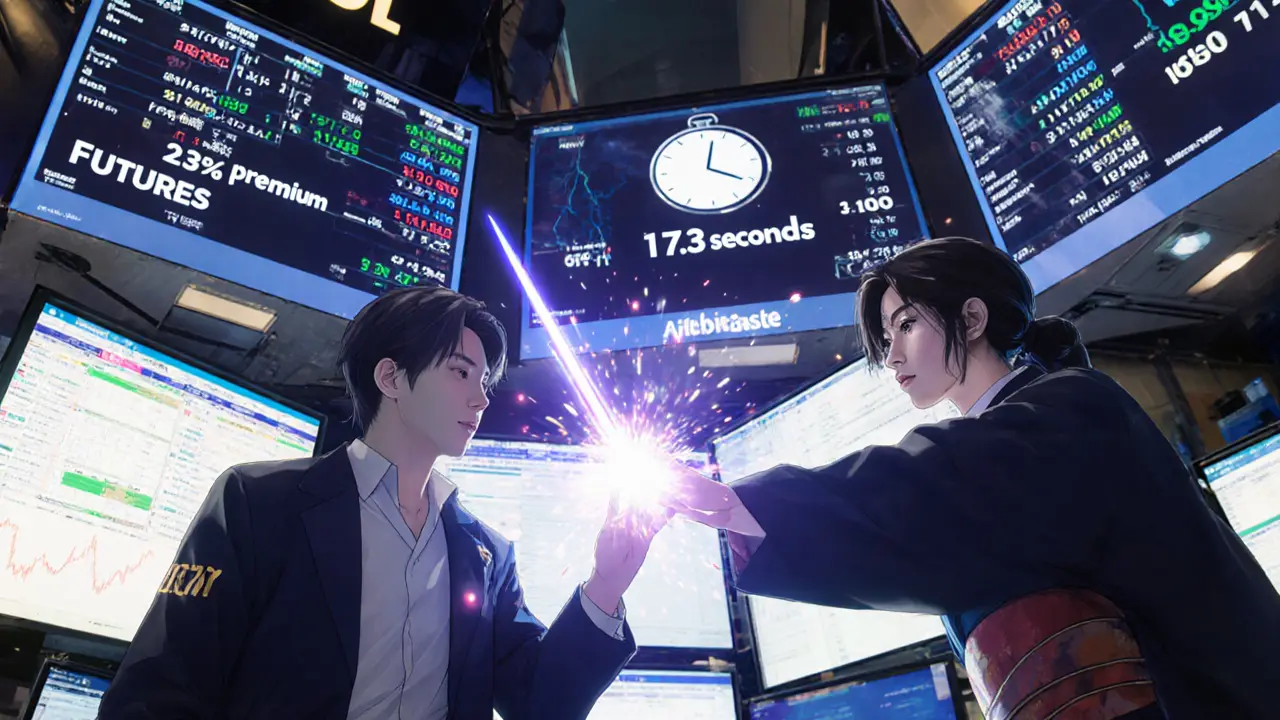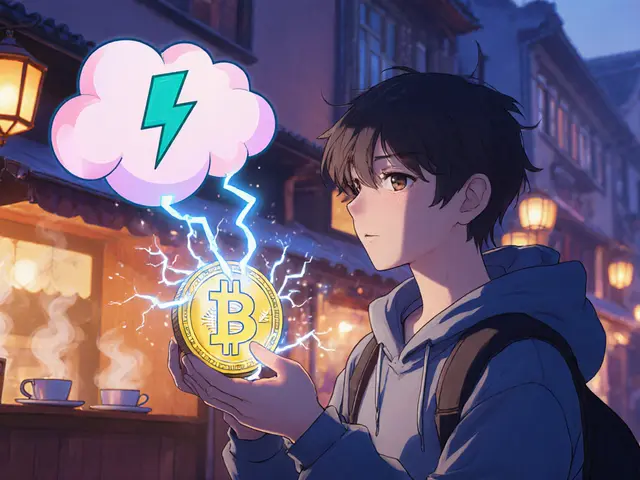Futures-Spot Convergence Calculator
Estimate Convergence Time
Enter asset class and market conditions to estimate how long it takes for futures and spot prices to converge.
How It Works
Convergence time depends on:
- Asset class liquidity
- Trading volume
- Arbitrage activity
- Market conditions
Convergence Time Estimate
This is the estimated time for futures and spot prices to converge based on your inputs and historical data from major exchanges.
When you hear that Bitcoin futures are trading at a premium, you might wonder why the spot price of Bitcoin isn’t instantly matching that level. The answer lies in the complex dance between futures contracts and the underlying spot market-a relationship that drives price discovery, tempers volatility, and can even dictate market efficiency. Below we break down how futures markets influence spot prices, why the effect varies across assets, and what traders should keep in mind when navigating crypto futures.
Key Takeaways
- The futures market typically leads price discovery, accounting for roughly 65% of the information flow to spot markets.
- Futures can both dampen and amplify spot price volatility, depending on whether shocks stem from consumption, production, or inventory.
- Arbitrage forces futures and spot prices to converge within seconds, but transaction costs and latency matter.
- Crypto futures behave similarly to commodity futures, yet regulatory nuances and market depth create distinct dynamics.
- Advanced models (GARCH, NARDL) and machine‑learning tools are now standard for forecasting spot prices from futures data.
What Is a Futures Market?
Futures market is a regulated venue where standardized contracts obligating the delivery of an asset at a future date are bought and sold. These contracts let participants lock in prices, hedge exposure, or speculate on future movements. The contract’s price reflects market expectations about supply‑demand balance, interest rates, storage costs, and risk premiums.
Understanding the Spot Market
Spot market is the arena for immediate exchange of an asset at the prevailing price. In crypto, the spot price appears on exchanges like Binance or Coinbase and adjusts in real time as buyers and sellers trade.
Price Discovery: Who Leads the Conversation?
Price discovery measures how quickly new information is reflected in prices. Empirical work by the University of Paris (2021) shows that futures markets contribute about 68.3% of the discovery weight for metals, energy, and agricultural commodities. In crypto, the price discovery function is similar: futures contracts on Bitcoin and Ethereum often move ahead of spot, especially during periods of high uncertainty.

Volatility Effects: Stabilizer or Agitator?
Volatility refers to the degree of price fluctuation over a given period. The direction of its impact hinges on the shock source. Research by Goetz, Miljkovic & Barabanov (2021) finds that futures markets can cut spot volatility by 22.8% when consumption shocks dominate, but they can raise it by up to 27.4% during production shocks. In crypto, a sudden futures‑driven liquidation cascade can spike spot volatility, while a well‑functioning futures market often smooths price swings by providing hedging avenues.
Arbitrage and Convergence: The Clock Is Ticking
Arbitrageurs exploit price gaps between futures and spot. CME Group data shows that such gaps typically vanish in 17.3 seconds on average, as traders buy the cheaper side and sell the expensive side, pushing prices together. However, transaction costs averaging 0.28% of contract value and latency in order‑book updates can erode profits, especially in thinly‑traded crypto futures.
Crypto Futures in Action: Bitcoin and Ethereum Cases
Bitcoin futures launched on the CME in 2017 and quickly became a barometer for spot sentiment. A study of 1,247 Bitcoin trading episodes (Reddit r/Trading, Jan 2023) found that when futures prices moved more than 3% away from spot, the spot price tended to revert about 12.4% within 72 hours, unless the move was driven by a fundamental supply shock (e.g., a major exchange hack).
Ethereum futures exhibit a similar pattern but with tighter convergence because of higher liquidity on platforms like Binance Futures. During the 2022 “Merge” hype, futures led spot by up to 5%, and spot adjusted within 45 minutes as arbitrageurs acted.
Comparison Across Asset Classes
| Asset Class | Futures Share of Price Discovery | Average Convergence Time (seconds) | Effect on Spot Volatility |
|---|---|---|---|
| Crude Oil | 92.4% | 12 | Typically stabilizes (‑18%) |
| Wheat | 58.7% | 22 | Mixed; stabilizes under consumption shocks |
| Gold | 71.3% | 15 | Reduces volatility (‑12%) |
| Bitcoin | 67.5% | 18 | Stabilizes when futures volume > spot volume |
| Ethereum | 70.1% | 16 | Minor stabilizing effect |
These numbers illustrate that while the futures market usually leads information flow, the speed of convergence and volatility impact differ widely. Crypto futures sit in the middle-faster than wheat but a bit slower than oil.

Modeling the Relationship: GARCH, NARDL & Machine Learning
Traditional risk models like GARCH (Generalized Autoregressive Conditional Heteroskedasticity) capture volatility clustering but often miss nonlinear spillovers from futures to spot. The NARDL (Nonlinear Autoregressive Distributed Lag) framework, requiring at least 1,500 daily observations for 95% confidence, handles asymmetric shock effects and has been applied successfully to oil‑futures‑spot pairs.
More recently, a University of Chicago working paper (2023) leveraged order‑book depth from Bitcoin futures to train a gradient‑boosting model, boosting spot‑price forecast accuracy by 31.7% over standard GARCH. For practitioners, combining a baseline GARCH with a futures‑derived feature set (e.g., open interest, basis) often yields the best risk‑adjusted returns.
Regulatory Landscape: CFTC, IOSCO & Emerging Rules
In the United States, the Commodity Futures Trading Commission (CFTC) enforces position‑limit rules that have been shown to cut spot volatility in energy markets by 18.3% while raising agricultural volatility by 9.7%. The International Organization of Securities Commissions (IOSCO) released guidance in 2024 urging exchanges to monitor 14 real‑time metrics, including the Price Discovery Measure (PDM) and Information Share (IS). Compliance improves market transparency and reduces the chance of flash‑crash spillover from futures to spot.
Future Outlook: Algorithmic Trading & Market Efficiency
The Bank for International Settlements predicts that by 2027, algorithmic trading will dominate futures volume (87.4%). Faster bots will shrink convergence windows to milliseconds, potentially magnifying error propagation to spot markets. However, higher efficiency also means better price alignment, assuming robust risk controls.
For crypto traders, the key is to stay informed about both the technical side-modeling, arbitrage, latency-and the regulatory side-position limits, reporting standards. Balancing these factors will let you harness the futures market impact on spot prices rather than get caught off‑guard.
Practical Checklist for Crypto Traders
- Monitor the futures‑spot basis (difference) in real time; a widening basis often signals upcoming spot moves.
- Use a hybrid model: GARCH for baseline volatility, plus a futures‑derived signal (open interest, funding rate).
- Keep an eye on transaction costs; a 0.28% fee can turn a 0.3% arbitrage profit into a loss.
- Stay compliant with CFTC‑style reporting if you trade on regulated futures platforms.
- Test latency: ensure your order‑execution engine can act within sub‑second windows to capture arbitrage.
Why do futures prices often move before spot prices?
Futures contracts aggregate expectations about future supply and demand, and because they settle later, traders can react to news earlier than spot market participants. This leads to a leading information flow, a phenomenon measured by the Information Share (IS) metric.
Can futures reduce spot volatility for cryptocurrencies?
Yes, when futures provide a hedging outlet, speculative pressure on the spot market eases, lowering price swings. However, if futures become overly leveraged, they can amplify moves, especially during rapid liquidations.
What is the typical time it takes for futures and spot prices to converge?
Across major asset classes, convergence averages 12‑22 seconds. In crypto, high‑frequency arbitrage can shrink this to under 5 seconds, but network delays and order‑book depth can lengthen it.
Do regulatory limits on futures affect spot markets?
Position‑limit rules curb extreme speculation, which tends to dampen spot volatility in energy markets. In agricultural commodities, the same limits have sometimes increased spot swings because they reduce liquidity in futures.
How can I use machine learning to improve spot forecasts?
Incorporate futures order‑book features-such as depth, bid‑ask spread, and funding rates-into a gradient‑boosting or LSTM model. Studies show this can boost forecast accuracy by roughly 30% compared to pure GARCH models.






Sara Stewart
September 16, 2025 AT 14:26 PMGreat breakdown! The futures‑spot basis is basically the market’s crystal ball – when it widens, you can often spot an imminent swing in the underlying. Arbitrageurs keep the spread tight, but latency and funding rates add a real‑time friction that traders need to watch. I love how the post highlighted the IS metric; it’s the backbone of price‑discovery analysis. Keep the jargon coming, it helps us all stay sharp on GARCH, NARDL, and the ever‑important order‑book depth.
Laura Hoch
September 16, 2025 AT 15:16 PMReading this feels like a philosophical journey through market psychology – the way futures encapsulate collective expectations is almost poetic. It’s fascinating how information filters down, turning abstract risk into concrete price moves. The piece does a solid job weaving theory with practical tips for traders.
Devi Jaga
September 16, 2025 AT 16:06 PMOh sure, because futures are always the brilliant oracle that never gets it wrong.
Ikenna Okonkwo
September 16, 2025 AT 16:56 PMI’m pretty optimistic about the direction this analysis is taking. Futures can indeed smooth out some of the wild swings we see in spot crypto, especially when the market depth is healthy. At the same time, it’s crucial to remember that over‑reliance on models can blind us to sudden regime shifts. Balancing hedging strategies with real‑time monitoring seems like the sweet spot. Keep the focus on both the data and the human element.
Carolyn Pritchett
September 16, 2025 AT 17:46 PMWow Sara, another paragraph packed with buzzwords that only a handful of “experts” pretend to understand. You’d think the average trader could use plain language instead of this jargon soup.
Miguel Terán
September 16, 2025 AT 19:10 PMLet me try to unpack this whole futures‑spot dance in a way that even a newcomer can follow without needing a PhD in econometrics The core idea is simple: futures contracts represent the market’s collective forecast about where an asset’s price will head in the future while the spot market reflects the current consensus price A key metric that keeps popping up is the Information Share (IS) which basically quantifies how much of the price‑discovery process is driven by futures versus spot data When IS is high for futures it means that the futures market is leading the conversation and pushing the spot price to adjust accordingly This is exactly what we see with Bitcoin and Ethereum where futures often move ahead of spot during periods of heightened uncertainty because traders can lock in expectations earlier The next piece of the puzzle is arbitrage This is the force that squeezes the basis – the difference between futures price and spot price – back toward zero in a matter of seconds High‑frequency traders watch the order book on both venues and jump on any temporary mispricing to lock in risk‑free profits The speed of convergence can be measured in seconds or even milliseconds in highly liquid markets and that’s why latency becomes a critical factor for anyone trying to capture that spread In practice you’ll see the convergence time for crypto futures hovering around 5‑10 seconds on deep venues like Binance but it can stretch out to 20‑30 seconds on thinner platforms where order‑book depth is limited Transaction costs also play a big role – a 0.28% fee can easily eat up a 0.3% arbitrage window making the trade unprofitable without ultra‑fast execution Finally there’s the modeling side where advanced techniques like GARCH capture volatility clustering while NARDL accounts for asymmetric shocks and machine‑learning models incorporate order‑book features like open interest and funding rates to boost forecast accuracy The takeaway is that futures are not just a speculative playground they are a vital conduit for information that, when used correctly, can give you an edge in anticipating spot moves
Shivani Chauhan
September 16, 2025 AT 20:00 PMThank you for the thorough explanation, Miguel. Your step‑by‑step breakdown makes the interaction between futures and spot much clearer, especially the role of IS and latency. The practical examples on convergence times are particularly helpful for traders looking to fine‑tune their arbitrage strategies.
Deborah de Beurs
September 16, 2025 AT 20:50 PMHonestly, the article missed the biggest risk – regulatory crackdowns that can halt futures trading overnight. Keep an eye on CFTC position limits.
Hailey M.
September 16, 2025 AT 21:40 PMWow, Deborah, that’s a bold claim! 😎🚀 If regulators swing the door shut, we’ll all be watching the drama unfold like a live‑stream thriller.
David Moss
September 16, 2025 AT 22:46 PMEveryone’s ignoring the hidden agenda here; the powers that be are manipulating futures data to control spot volatility. It’s all a staged performance, and the public never sees the strings.
Pierce O'Donnell
September 16, 2025 AT 23:36 PMSounds like overcomplication to me.
DeAnna Brown
September 17, 2025 AT 00:26 AMHold on, David – the idea that some shadowy cabal is pulling the levers is pure fantasy. The market dynamics you described are well‑documented in academic research and regulatory filings, not some Hollywood conspiracy. Let’s stick to the facts.
Bobby Lind
September 17, 2025 AT 01:33 AMOverall, great insights, lots of useful data, and a clear reminder that staying adaptable, monitoring fees, and respecting latency are key, especially in a fast‑moving space like crypto futures.